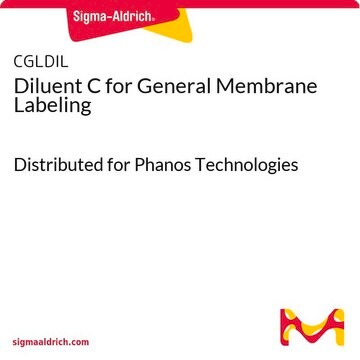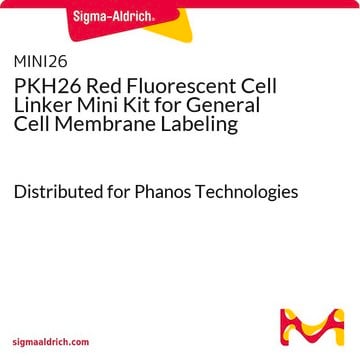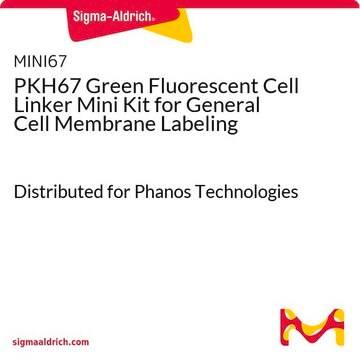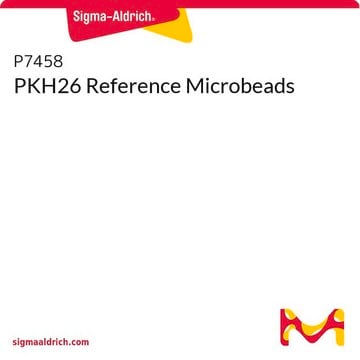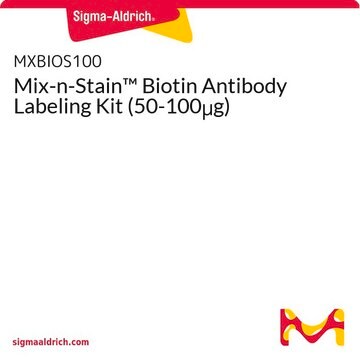MINCLARET
CellVue® Claret Far Red Fluorescent Cell Linker Mini Kit for General Membrane Labeling
Distributed for Phanos Technologies
Synonym(s):
Far red membrane labeling kit
Sign Into View Organizational & Contract Pricing
All Photos(1)
About This Item
UNSPSC Code:
12352207
NACRES:
NA.32
Recommended Products
packaging
pkg of 1 kit
manufacturer/tradename
Distributed for Phanos Technologies
storage condition
protect from light
technique(s)
flow cytometry: suitable
fluorescence
λex 655 nm; λem 675 nm (CellVue claret dye)
application(s)
cell analysis
detection
detection method
fluorometric
shipped in
ambient
storage temp.
room temp
Application
CellVue Claret kit fluoresces in the far red and may be used for general cell membrane labeling including in vitro cell labeling, in vitro lymphocyte proliferation studies,† in vivo cytotoxicity assays,† and also as a second color for monitoring cell-cell membrane transfer.†
CellVue® Claret Far Red Fluorescent Cell Linker Mini Kit for General Membrane Labeling has been used:
- to label monocyte-derived macrophages (MDMs) for antibody-dependent cellular phagocytosis assay
- in labeling of Jurkat cells after the induction of apoptosi
- in labeling of cells in mice for assaying the retention of tumor cells in lung
Biochem/physiol Actions
The CellVue Claret Fluorescent Cell Linker kit uses a proprietary membrane labeling technology to stably incorporate a far red fluorescent dye with long aliphatic tails (CellVue Claret) into lipid regions of the cell membrane.†
Packaging
This kit provides enough dye for up to 25 samples of 20 million cells each and enough diluent for up to 5 samples of 20 million cells each, when using a 2 mL final staining volume containing a final concentration of 2 x 10-6 M of PKH26 dye. Users must determine the optimal dye and cell concentrations from their cell type(s) and experimental purposes.
Linkage
For additional technical details on Fluorescent Cell Linker Dyes including a comprehensive bibliography, please visit PKH and CellVue®; Claret Fluorescent Cell Linker Dyes.
Legal Information
Distributed for Phanos Technologies, Inc.
Patent Information
Patent Information
CellVue is a registered trademark of Phanos Technologies
Signal Word
Danger
Hazard Statements
Precautionary Statements
Hazard Classifications
Eye Irrit. 2 - Flam. Liq. 2
WGK
WGK 1
Certificates of Analysis (COA)
Search for Certificates of Analysis (COA) by entering the products Lot/Batch Number. Lot and Batch Numbers can be found on a product’s label following the words ‘Lot’ or ‘Batch’.
Already Own This Product?
Find documentation for the products that you have recently purchased in the Document Library.
Customers Also Viewed
The detergent-soluble cytoplasmic pool of survivin suppresses anoikis and its expression is associated with metastatic disease of human colon cancer
Hori M, et al.
Testing, 8(2), e55710-e55710 (2013)
Roberts Rimsa et al.
Micromachines, 12(5) (2021-06-03)
Current in vitro models have significant limitations for new respiratory disease research and rapid drug repurposing. Lung on a chip (LOAC) technology offers a potential solution to these problems. However, these devices typically are fabricated from polydimethylsiloxane (PDMS), which has
Comparative assessment of clinically utilized CD20-directed antibodies in chronic lymphocytic leukemia cells reveals divergent NK cell, monocyte, and macrophage properties
Rafiq S, et al.
Journal of immunology (Baltimore, Md. : 1950), 190(6), 2702-2711 (2013)
Kerry L Inder et al.
Journal of extracellular vesicles, 3, doi:10-doi:10 (2014-07-16)
Tumour-derived extracellular vesicles (EVs) play a role in tumour progression; however, the spectrum of molecular mechanisms regulating EV secretion and cargo selection remain to be fully elucidated. We have reported that cavin-1 expression in prostate cancer PC3 cells reduced the
Justin L Spinner et al.
Journal of leukocyte biology, 95(3), 389-398 (2013-11-15)
Yersinia pestis, the bacterial agent of plague, is transmitted by fleas. The bite of an infected flea deposits Y. pestis into the dermis and triggers recruitment of innate immune cells, including phagocytic PMNs. Y. pestis can subvert this PMN response
Our team of scientists has experience in all areas of research including Life Science, Material Science, Chemical Synthesis, Chromatography, Analytical and many others.
Contact Technical Service


